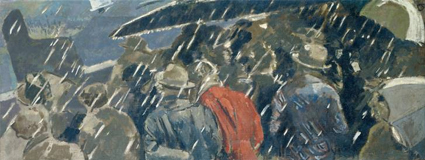WALTER SICKERT's habit of basing paintings on news photographs shocked some people in the early decades of this century but now it makes him look proto-modern, or even proto-Post-Modern - one of the first painters to register the second-hand, mediated quality of so much urban 20th- century experience, of lives lived out in front of TV screens or the turning pages of newspapers. But on the evidence of the Sickert retrospective that opened last week at the Royal Academy in London, he saw the news photograph more as a challenge than as a subject in its own right. It was a test of his own powers as a painter to reconstruct, from grainy black and white images in newspapers like the Daily Sketch, the realities that lay behind them.
Sickert sifted through photographs like a private detective looking for incriminating evidence. Pretty often, he found it. Two of the last paintings to be seen in the current exhibition are his pair of portraits of HM Edward VIII based on a single photograph taken by Harold J Clements (Sickert always acknowledged his sources). Seen together, they add up to a snapshot of the painter at work, homing in on the salient details of the image. Sickert's second Edward VIII is a masterpiece, a daringly enlarged painting of a photograph in which the frailty and loneliness of a human being are suddenly and simply reincarnated.
The King steps forward hesitantly into the public eye, clutching his bearskin defensively like a shield and glancing uneasily to one side. Sickert's handling - sketchy, incomplete - seems calculated to match his subject. His picture of Edward VIII was painted, with irony, on the scale of a state portrait; in fact, it is an anti-state portrait, a picture of a king involuntarily revealing, in...

Snapshots in paint
24-11-1992

